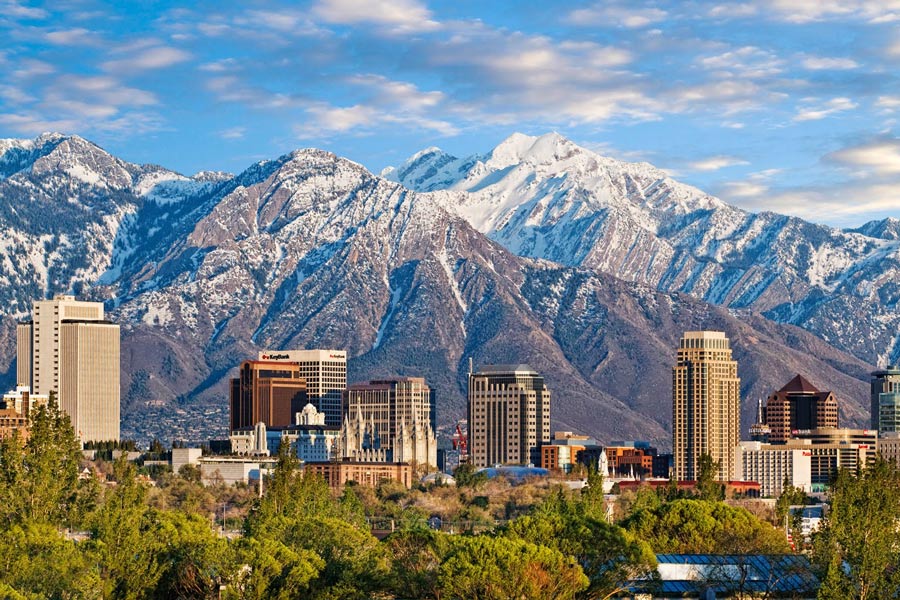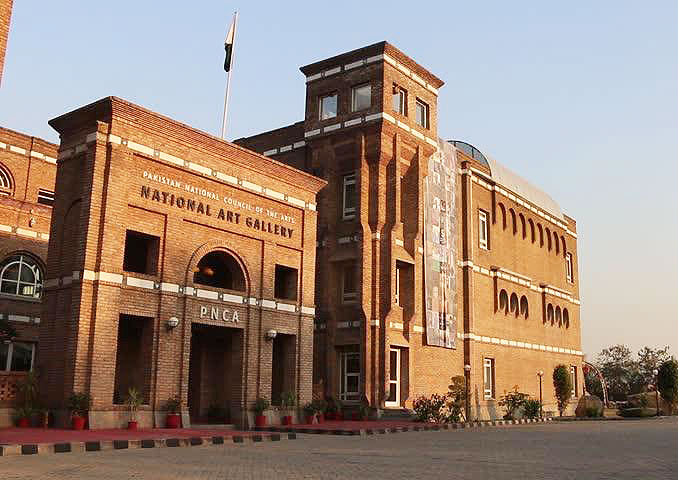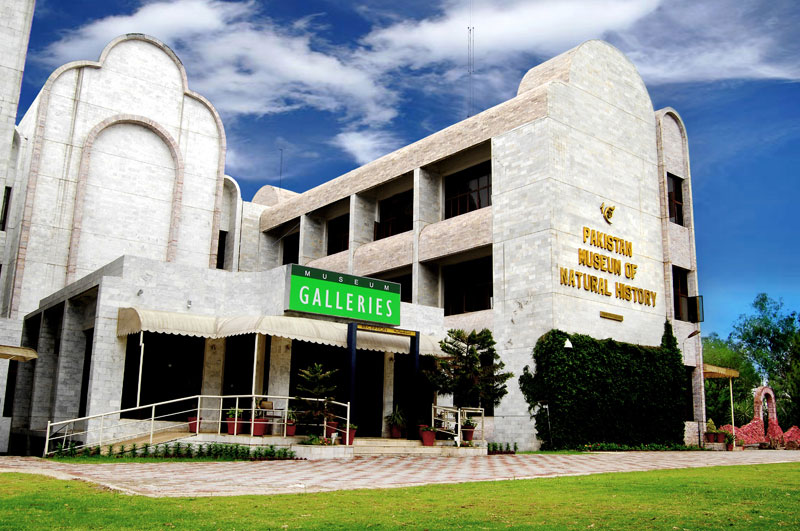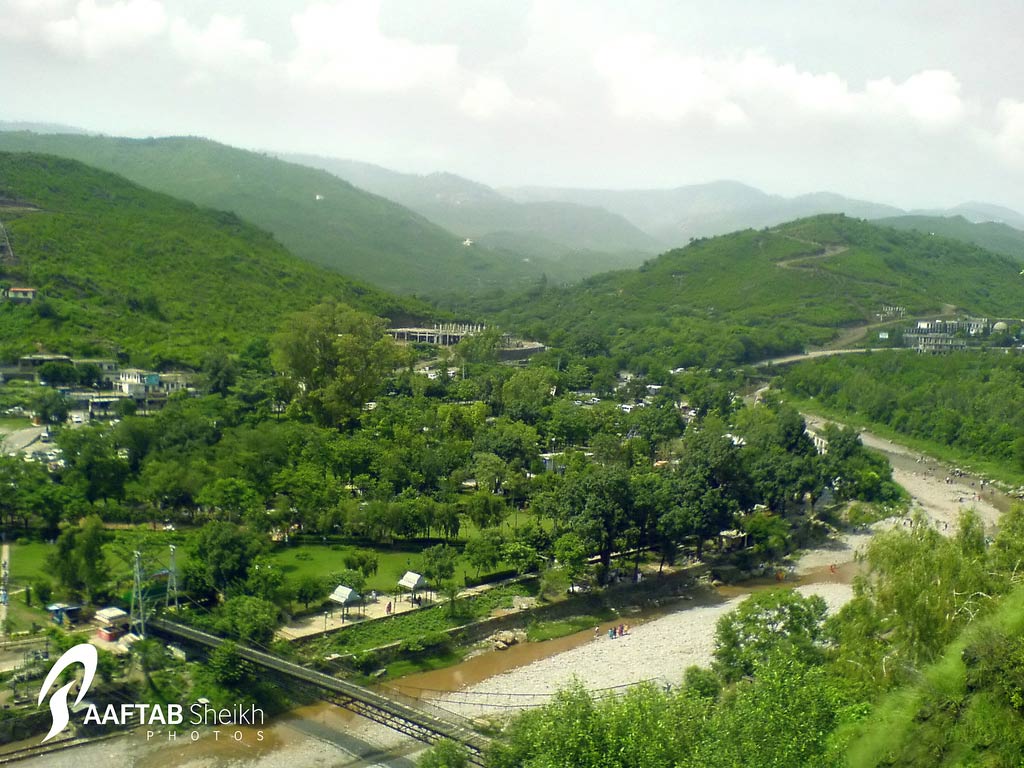
Islamabad (/ɪzˈlɑːməˌbɑːd/; Urdu: اسلام آباد Islāmābād [ɪsˌlɑːmɑːˈbɑːd̪]) is the capital city of Pakistan located within the federal Islamabad Capital Territory. With a population of 1,014,825 at the 2017 Census, it is the 9th largest city of Pakistan, while the larger Islamabad-Rawalpindi metropolitan area is the third largest in Pakistan with a population exceeding four million. The city is the political seat of Pakistan and is administered by the Islamabad Metropolitan Corporation, supported by the Capital Development Authority (CDA).
 Islamabad is located in the Pothohar Plateau in the northeastern part of the country, between Rawalpindi District and the Margalla Hills National Park to the north. The region has historically been a part of the crossroads of Punjab and Khyber Pakhtunkhwa with the Margalla Pass acting as the gateway between the two regions.
Islamabad is located in the Pothohar Plateau in the northeastern part of the country, between Rawalpindi District and the Margalla Hills National Park to the north. The region has historically been a part of the crossroads of Punjab and Khyber Pakhtunkhwa with the Margalla Pass acting as the gateway between the two regions.
Islamabad was built during the 1960s to replace Karachi as Pakistan’s capital. The city’s master-plan, designed by Constantinos Apostolou Doxiadis, divides the city into eight zones, including administrative, diplomatic enclave, residential areas, educational sectors, industrial sectors, commercial areas, and rural and green areas. The city is known for the presence of several parks and forests, including the Margalla Hills National Park and Shakarparian Park. The city is home to several landmarks, including the Faisal Mosque, the largest mosque in South Asiaand the fourth largest in the world. Other landmarks include the Pakistan’s National Monument and Democracy Square.
 Islamabad is a beta-world city;] it is categorized as very high on the Human Development Index, with an HDI of 0.875, the 2nd highest in the country after Lahore. The city has the highest cost of living in Pakistan, and its population is dominated by middle and upper middle class citizens. The city is home to twenty universities, including the Quaid-e-Azam University, PIEAS, COMSATS Institute of Information Technology and NUST. The city is one of the safest in Pakistan, and has an expansive surveillance system with 1,900 CCTV cameras.
Islamabad is a beta-world city;] it is categorized as very high on the Human Development Index, with an HDI of 0.875, the 2nd highest in the country after Lahore. The city has the highest cost of living in Pakistan, and its population is dominated by middle and upper middle class citizens. The city is home to twenty universities, including the Quaid-e-Azam University, PIEAS, COMSATS Institute of Information Technology and NUST. The city is one of the safest in Pakistan, and has an expansive surveillance system with 1,900 CCTV cameras.
(wikipedia.org)
Mosques & Shrines
Faisal Mosque
This beautiful mosque was designed by a renowned Turkish Architect, Vedat Dalokay and named after the late King Faisal of Saudi Arabia. It is spread over 1,89,705 sq.metres with 88 meters high minarets and 40 meters high main prayer hall. The main prayer hall can accommodate 10,000 persons while the covered porticos and verandahs can take over 24,000 worshipers. The main courtyard has space for 40,000 people.
Shrine of Shah Abdul Latif (Bari Imam)
 Noorpur Shahan, a village situated at the foot of Margallah Hills, near Quaid-e-Azam University, is famous for the mirror-studded shrine of Hazrat Shah Abdul Latif Kazmi, popularly known as Bari Imam. The shrine was originally built on the orders of Mughal emperor Aurangzeb. The death anniversary (Urs) of Bari Imam is observed in the first week of May beginning Monday through Thursday with lot of festivities representing the Potohar culture and attracts people from all over the country. There is a cave in the Margallah Hills on the back of the shrine where Bari Imam used to sit for meditation. A mosque, where he preached and acted as Imam, is located on Hill Road. The tomb of his father is located on the Shahrah-e-Kashmir opposite the Aabpara Market. Bari Imam is said to have predicted that a new city would be built near his tomb, which will greatly serve the cause of Islam.
Noorpur Shahan, a village situated at the foot of Margallah Hills, near Quaid-e-Azam University, is famous for the mirror-studded shrine of Hazrat Shah Abdul Latif Kazmi, popularly known as Bari Imam. The shrine was originally built on the orders of Mughal emperor Aurangzeb. The death anniversary (Urs) of Bari Imam is observed in the first week of May beginning Monday through Thursday with lot of festivities representing the Potohar culture and attracts people from all over the country. There is a cave in the Margallah Hills on the back of the shrine where Bari Imam used to sit for meditation. A mosque, where he preached and acted as Imam, is located on Hill Road. The tomb of his father is located on the Shahrah-e-Kashmir opposite the Aabpara Market. Bari Imam is said to have predicted that a new city would be built near his tomb, which will greatly serve the cause of Islam.
Shrine of Syed Meher Ali Shah
The shrine of Syed Meher Ali Shah of Golra Sharif is located 18 km from Rawalpindi, in sector E-11 of Islamabad. He was descendant of a Syed family and had links with Syed Abdul Qadir Gilani of Baghdad. He was born in 1859, preached and spread the message of Islam during the turbulent times in South Asia. He also wrote beautiful prose and poetry in Persian, Arabic and Punjabi languages, mostly in praise of God and Muhammad (peace be upon him). He died on May 11, 1937. His mausoleum was recently reconstructed comprising of a dome, and a high minaret built with marble. Devotees assemble here on the occasion of annual Urs.
Saidpur Village
Saidpur, a little quaint village, famous for its pottery, is part of Islamabad today. It is located off the Hill Road to the east of Daman-e-Koh. Sultan Said Khan son of Sultan Sarang Khan founded Saidpur. He gave his daughter in marriage to Mughal Prince Saleem who later became Emperor Jehangir. Saidpur was considered a garden resort and a perpetual spring provided water for drinking and for watering gardens around during the Mughal period.
Art Galleries & Museums
 PNCA Art Gallery
PNCA Art Gallery
Idara Saqafat-e-Pakistan (Pakistan National Council of the Arts) runs two art galleries. The National Gallery is located at House # 77, Street # 48, F-7/4, Islamabad (Tel: 9204951), where contemporary Pakistani art is on permanent display besides revolving exhibitions & paintings available for sale. The other is Children Art Palace, # 77 School Road, F-7/4, Islamabad, where Children’s art is on display and regular art classes held for children.
Lok Virsa Heritage Museum & Library
With a covered area of 60,000 sq.ft, the Lok Virsa Heritage Museum is the first state museum of ethnology that presents the history and living traditions of the people of Pakistan in a chronological sequence. It offers an enchanting journey through glorious civilizations of the past to the present day traditions. It is a walk through corridors of history placed in a setting that absorbs the visitor in its splandour. The museum has a large display of embroidered costumes, jewellery, woodwork, metal work, block printing, ivory and bone work. Traditional architectural facade exhibiting such skills as fresco, mirror work, marble inlay, tile mosaic and stucco tracery from different regions of Pakistan. Heritage Museum remains open daily from 10 a.m. to 8 p.m. Monday is weekly off. Entry ticket is Rs. 25/- for Pakistanis and Rs.200/- for foreign visitors (Tel: 9201685, 9203983).
Lok Virsa Heritage Library is equipped with resource data on ethnography, anthropology, folk music, art, crafts and history. Books, video and audio cassettes/CDs containing documentaries on folk culture, folk heritage, folk and classical vocal and instrumental music are also available for sale at the Lok Virsa Sales Centre. Annual Artisans-at-Work Festival is also organized during the month of April.
 Pakistan Museum of Natural History
Pakistan Museum of Natural History
The Museum of Natural History is on Garden Avenue in National Park Area. The Museum depicts the early human history, geology, and the wild life of Pakistan. The exhibits are of particular interest to students and children. It is open to public from 9:00 a.m. to 4:00 p.m. except Friday. Entry is free.
Islamabad Museum
Islamabad museum presents a long historic sequence of the land where Pakistan is situated today. Pakistan has been a seat of the world’s leading civilizations from the time immemorial. There is plenty of evidence to support this argument now on display in Islamabad Museum. For example, 20 million years old fossil remains, 2 million years old man-made stone tools, 7000 years old early human settlements, which lead to the world famous Indus Civilization, Gandhara Grave Culture and Gandhara art, early Islamic settlements, Sultanate and Mughal period, their art and craft.
The Museum is located at Sir Syed Memorial Building, Islamabad. It is open for visitors, Thursday to Tuesday, from 09:30 to 16:30 hrs without break. Wednesday is weekly off and there is a prayer break on every Friday from 12:30 to 14:00 hrs .
Parks And Gardens
 Rose and Jasmine Garden
Rose and Jasmine Garden
This 20,360 sq. meters rose garden is famous for its roses. It has 250 different varieties of roses as well as a dozen types of Jasmines. Flower shows are occasionally held here, particularly during spring. Nearby is the Tourist Camping Site.
Shakarparian Hills
Shakarparian hills are situated near Zero Point, at a height of 609 meters. Its terraced garden offers pleasant and sweeping vistas of Margallah and Murree hills, Rawal Lake, Rawalpindi and Islamabad. Snack Bar facilities are available.
Daman-e-Koh
Daman-e-Koh offers panoramic view of Islamabad. Snack bar facilities are available at PTDC’s Daman-e-Koh Restaurant. The place is ideal for afternoon and evening outing with family and friends.
Murghzar Mini Zoo and Children’s Park
Murghzar Mini zoo is located at the foot of Daman-e-Koh viewpoint. A Japanese style children’s park have also been established near the Zoo. This Park is a gift to Pakistani children from the children of Japan.
Fatima Jinnah Park
The entire sector of F-9 is being developed as an attractive urban park, which will have a profusion of lakes, rock gardens, aquariums, fountains etc. It has been named after Miss Fatima Jinnah, sister of the founder of Pakistan.
 Chattar Bagh (Park)
Chattar Bagh (Park)
Nestling at the base of Murree hills at a distance of 15 km on Islamabad-Murree road, TDCP Chattar Bagh recreational facility provides a quiet break from the hustle and bustle of the twin cities. Scenic walks, gently flowing stream, waterfall and the surrounding hillside are a perfect attraction. The resort has a restaurant, barbecue and two air-conditioned tourist cottages. The Children’s Park and playground are spread over an area of 12.5 acres.
Islamabad Sports Complex
A Sports Complex comprising Liaquat Gymnasium for indoor games and Jinnah Stadium for outdoor games has been built with the Chinese assistance. It is located on Shahrah-e-Kashmir near Aabpara. Regular national and international sports events are held in the Complex. For details, please contact Pakistan Sports Board, Islamabad Sports Complex, Shahrah-e-Kashmir, Islamabad.
Lakes & Dams
Rawal Lake
 Rawal Lake in Pakistan is an artificial reservoir that provides the water needs for the cities of Rawalpindi and Islamabad. Korang River along with some other small streams coming from Margalla Hills have been set to form this artificial lake. Korang River is the outlet stream of Rawal Dam. Rawal Lake is located within an isolated section of the Village Malpur, Bani Gala and Margalla Hills National Park.
Rawal Lake in Pakistan is an artificial reservoir that provides the water needs for the cities of Rawalpindi and Islamabad. Korang River along with some other small streams coming from Margalla Hills have been set to form this artificial lake. Korang River is the outlet stream of Rawal Dam. Rawal Lake is located within an isolated section of the Village Malpur, Bani Gala and Margalla Hills National Park.
As of June 2018 Rawal lake has reached its dead level and supply of water to the twin cities is one of the biggest concern these days. This glistening man-made lake covers an area of 8.8 sq. km. The terraced garden and the lake are ideal for picnic, fishing and boating. The highest point in the garden commands a panoramic view of the lake, Margallah and Murree hills, Rawalpindi and Islamabad. The PTDC Jaltarang Restaurant offers snack bar facilities for visitors.
Simli Lake
About 30 km from Islamabad lies Simli Lake and the Dam. It can be reached via Lehtrar road or via Bhara Kahu. It is fed by the melting snow and natural springs of Murree hills. The water stored in the lake is supplied to Islamabad for drinking purposes. Angling and boating is also allowed in the lake. The Capital Development Authority (CDA) has a Rest House at the Dam, which can be booked through its Head Office in Islamabad.
Khanpur Lake
This beautiful lake/dam is 48 km from Islamabad, on Taxila-Haripur Road. It is an ideal place for day trip/picnic, boating, angling and watching migratory birds during winter.

